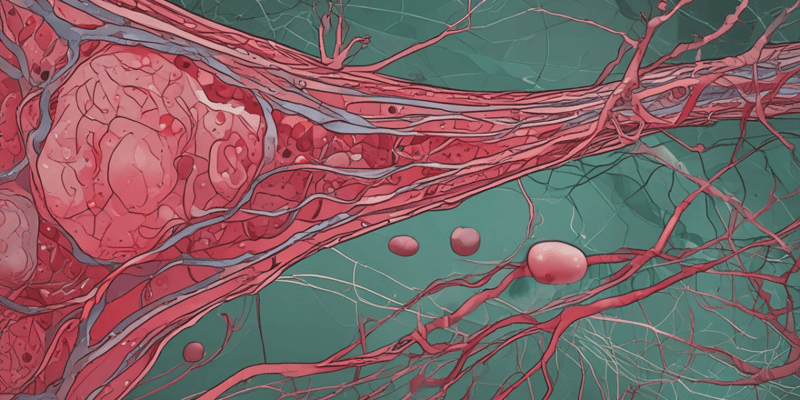Questions and Answers
Which type of blood vessel typically contains no elastic fibers?
What is the purpose of vasa vasorum found in large veins?
Which layer is found in both arteries and veins but has different compositions?
What type of cells line the endothelial layer of blood vessels?
Signup and view all the answers
What is the function of the internal elastic lamina in arteries?
Signup and view all the answers
What medical condition can arise from damaged endothelial cells through atherosclerosis?
Signup and view all the answers
What is the main component found in the tunica media of blood vessels?
Signup and view all the answers
Which blood vessel is responsible for carrying deoxygenated blood back to the heart?
Signup and view all the answers
What type of blood does the umbilical artery carry?
Signup and view all the answers
What is the composition of the tunica media in the umbilical artery?
Signup and view all the answers
What material surrounds the adventitia of the umbilical artery?
Signup and view all the answers
What is a possible consequence of a weakened tunica media in an artery?
Signup and view all the answers
How do immediate postcapillary venules compare structurally to capillaries?
Signup and view all the answers
What characterizes the tunica media of large arteries like the aorta?
Signup and view all the answers
Which statement accurately describes medium-sized arteries compared to medium-sized veins?
Signup and view all the answers
What feature is absent in the tunica intima of the basilar artery?
Signup and view all the answers
What is the primary function of vasa vasorum found in the tunica adventitia of large arteries?
Signup and view all the answers
Which artery is characterized by having a thick internal elastic lamina and a thin wall with a wide lumen?
Signup and view all the answers
How does the wall structure of the coronary artery differ from a typical medium-sized artery?
Signup and view all the answers
Which property is true regarding the flow of blood in medium-sized arteries compared to medium-sized veins?
Signup and view all the answers
What distinguishes the tunica adventitia of medium-sized veins from that of medium-sized arteries?
Signup and view all the answers
Study Notes
Types of Blood Vessels
- Blood vessels are classified into arteries, veins, and capillaries.
- Major blood vessels include the aorta and inferior vena cava for arteries and veins, respectively.
- Arterioles and venules are smaller branches of arteries and veins, leading to capillary networks.
Structure of Blood Vessels
- Blood vessels consist of three tunics: tunica intima, tunica media, and tunica adventitia.
- Tunica Intima: Innermost layer featuring simple squamous epithelium with a subendothelial loose connective tissue layer rich in elastic fibers.
- Tunica Media: Middle layer largely composed of smooth muscle and elastic fibers, thicker in arteries compared to veins.
- Tunica Adventitia: Outer layer containing collagen fibers, elastic fibers, and the vasa vasorum, which nourishes the vessel walls.
Characteristics of Large Arteries
- Large arteries, like the aorta, have thick walls and wide lumens accommodating high blood pressure and flow.
- The tunica media is elastically rich, allowing for recoil after stretching, vital for maintaining blood pressure.
- The intima is thicker compared to muscular arteries and contains internal elastic lamina, though it may not be prominently visible.
Medium-Sized Arteries and Veins
- Medium-sized arteries have thick walls with narrow, round lumens that accommodate rapid blood flow.
- Medium-sized veins feature thinner walls with wider, collapsed lumens and valves to prevent backflow.
- Internal elastic lamina is well-developed in medium-sized arteries but absent in veins.
- Muscular venules show some structural differences with two to three layers of smooth muscle in the tunica media.
Specialized Medium-Sized Arteries
- Basilar Artery: Located in the brain, has thin walls, a wide lumen, and a prominent internal elastic lamina.
- Coronary Arteries: Supply the heart muscle; possess unique structural features like an amorphous subendothelial layer and external elastic lamina.
- Umbilical Artery: Found in umbilical cords, carries deoxygenated blood without an internal elastic lamina.
Medical Applications
- Endothelial cells play a critical role in preventing blood coagulation; damage can lead to thrombus formation.
- Aneurysms occur due to weakness in the tunica media; rupture poses severe health risks, possibly fatal.
- Vasa vasorum are crucial for supplying nutrients to larger vessel walls, especially in veins which often lack elastic fibers.
Venules
- Immediate postcapillary venules are structurally similar to capillaries and are surrounded by pericytes.
- Muscular venules are larger, featuring tunica media with a few smooth muscle layers, facilitating blood flow from capillary beds back to veins.
Studying That Suits You
Use AI to generate personalized quizzes and flashcards to suit your learning preferences.
Description
This quiz covers the classification and structure of blood vessels, including arteries, veins, and capillaries. Learn about their major components such as tunica intima, tunica media, and tunica adventitia, along with the characteristics of large arteries. Test your knowledge on the anatomy and function of the vascular system.




